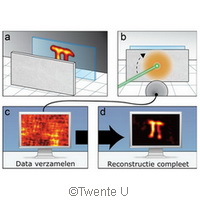Looking through the opaque screen for sharper images
Taking images through opaque, light-scattering layers is a vital capability and essential diagnostic tool in many disciplines, including nanotechnology and the biosciences. Current techniques are unable to image through opaque layers that scatter all the incident light. Even a very thin layer of a scattering material can appear opaque and hide any objects behind it. Now, a joint research team from Italy and the Netherlands have succeeded in taking non-invasive sharp pictures of objects hidden behind a screen of opaqueness. The study, which was supported by the European Research Council (ERC), has been published in the journal Nature. Skin and other materials such as paper and ground glass appear opaque because they scatter light. Many may remember the image of light bending when it strikes a prism. When light strikes these opaque materials it ceases to move in a straight line, and instead travels along an unpredictable and erratic path. The result of this is that it becomes impossible to get a clear view of objects lying behind such materials. Powerful methods have been developed to retrieve images through materials in which a small fraction of the light follows a straight path. To date, however, it has not been possible to resolve an image from light that has been completely scattered. In the researchers' report they acknowledge the great progress which has been made in recent years with methods such as ghost imaging and wave-front shaping; however, they note that present procedures are still invasive because they require either a detector or a non-linear material to be placed behind the scattering layer. Their report, however, describes their breakthrough, namely an optical method that allows non-invasive imaging of a fluorescent object that is completely hidden behind an opaque scattering layer. The researchers, led by Dr Allard Mosk, scanned the angle of a laser beam that illuminated an opaque diffuser. At the same time, a computer recorded the amount of fluorescent light that was returned by a tiny object hidden behind the diffuser. Dr Mosk pointed out that, 'While the measured intensity of the light cannot be used to form an image of the object directly, the information needed to do so is in there, but in a scrambled form.' 'The two young scientists who are the first authors of this paper had the brilliant idea to find out whether that scrambled information is sufficient to reconstruct the image - and they found a way to do so,' he added. Their method involves a computer programme that initially guesses the missing information, and then tests and refines the guess. They succeeded in making an image of a hidden fluorescent object such as a typical cell, which can be merely 50 micrometres across. The researchers realise that their breakthrough is just the beginning and expect their work to lead to new microscopy methods capable of forming razor sharp images in a strongly scattering environment. Dr Mosk noted: 'This will be very useful in nanotechnology. We would like to bring structures to light that are hidden inside complex environments like computer chips.' The researchers also dream of extending their method to examine objects under the human skin. 'But for the moment,' said Dr Mosk, 'our method is too slow for that.' In addition to the support they received from the ERC, they were also supported by The Netherlands Organisation for Scientific Research (NWO), the Foundation for Fundamental Research on Matter, the Technology Foundation STW, and the Italian Ministry of Education, Universities and Research.For more information, please visit: University of Twente http://www.utwente.nl/en/ European Research Council http://erc.europa.eu/
Countries
Netherlands



